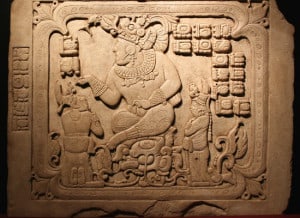By TARRA SABIN –
Generally speaking our history books imply that the Aztecs were Mexico’s dominant and ruling tribe when Hernán Cortés and the Spanish conquistadores arrived. They also give the impression that the Aztecs were the original indigenous people of Central Mexico.

Actually, neither assumption is true. The Aztecs, also knows as the Mexica, were relative newcomers to Mexico when the Spanish arrived in the early 1500s. They had only been in Mexico about 300 years, and they never conquered all the Central Mexican tribes.
Writings by Fray (Friar) Diego Durán, considered by most scholars to be the leading authority on pre-Columbian history, language, and customs, say that around 900 A.D. six tribes of people came to Mexico from a place near the present-day state of Florida, which they called Aztlán. Some have speculated that these tribes were remnants of survivors of the legendary continent of Atlantis.
Around 300 years later, in the early 1200s, a seventh related tribe, the Aztecs, arrived in Central Mexico. According to the history of these seven tribes (including the Aztecs), when they arrived Mexico was already inhabited by two distinctly different groups of people. In the western mountains, which the Spanish named the Sierra Madre Occidentál, were a people called Chichimecs or Chichimecas. In the east, in the areas of present-day Puebla and Cholula were the Quiname, which meant “men of great stature.” Both the Chichimecas and the Quiname were said to have been at least 7 to 8 feet tall.

When the newer tribes arrived, they set out to rid the land of the people already living there. They killed thousands, but many fled high into the Sierra, hiding themselves in isolated areas. The Huichol and the Cora Indians are believed to be descendants of those Chichimecas. Not only were their lives saved, but their cultures have survived fairly intact because of their isolation from the newcomer tribes, and later the Spanish, who also sent masses of troops augmented by their Indian allies into the mountains for the express purpose of eliminating them.
The Quiname refused to give up their homeland and fought valiantly to defend it. But they were greatly outnumbered, especially when the tribes allied against them. Many were slaughtered through trickery. Others flung themselves from cliffs and precipices, rather than be conquered. They were harrassed and pursued until almost all were destroyed. It is believed some may have migrated to other parts of Mexico, farther north.
Giants2b
In this Mayan relief, giants are depicted standing on the backs of smaller beings.
For example, the Seri, a giant tribe of Indians found by Coronado, were living on the island the Spanish named Tiburón and the adjacent coast of Sonora on the Gulf of California. Coronado’s men described the Seri as being so huge that the tallest of the Spaniards only came to their waists or lower chests.
Farther north, in what is now the state of Arizona, Coronado encountered the Cocopa, a Yuman tribe. All were reported to be over 8 feet tall and incredibly strong. Coronado’s historian noted that six of the Spaniards tried to carry a large log to the fire and were unable to move it. A Cocopa man lifted it easily onto his head and carried it to the fire.
Others obviously survived, as well. Bernardino de Sahugan, who arrived in Mexico in 1523, and was considered to be the foremost authority of his time on the pre-conquest Aztec culture, wrote of the “giants of Quinametin” and even asserted that they built both Teotihuacán and Cholula.
Bernard Diaz del Castillo, another Spanish historian who served in the army of Hernán Cortés during his conquest of Mexico, wrote about the Tlaxcaltecs, who eventually became one of Cortés’ most loyal allies. They related to Diaz that a race of huge people had once lived among their ancestors, the Olmecs. They even brought the skeptical Diaz a femur, or thigh bone, from one giant’s remains. Diaz described it as being “very thick and the height of an ordinary-sized man.”
 Other reports of giants have come out of Mexico, For example, Joseph de Acosta told of finding a buried giant on his farm in Mexico in 1586. He said not only were the bones “enormous,” but a tooth was found “the size of a man’s fist.”
Other reports of giants have come out of Mexico, For example, Joseph de Acosta told of finding a buried giant on his farm in Mexico in 1586. He said not only were the bones “enormous,” but a tooth was found “the size of a man’s fist.”
Another example comes from Nayarit, where a press clipping dated May 14, 1926, states that Capts. D.W. Page and F.W. Devalda discovered the bones of a race of giants who averaged over ten feet in height. Local legends say the race of giants came from Ecuador.
Probably the most mysterious recent-day account of the ancient giants of Mexico came from explorer Paxton Haynes. He was exploring the Barranca de Cobre area (Copper Canyon) in northern Mexico in the early 1930s. In a cave there he allegedly discovered the mummified bodies of 34 men and women. All measured between 7 and 8 feet in height, and all had blond hair.
THIS ARTICAL WAS POSTED FIRST HERETarraSabinABOUT THE AUTHOR: Tarra Sabin
Tarra’s articles are well-known to Lakesiders. She has lived in Mexico since 1992, spending many years among the reclusive Huichol Indians, learning their indigenous culture. Her years here have given her a unique understanding and perspective of our Mexican hosts. In addition to being a writer, Tarra is a certified naturopath and nutritionist. She can be contacted at nutridoc@ymail.com.



















